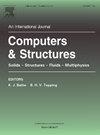Combining non-linear structural modeling and machine learning for tensile behavior of multi-layered randomized architected material
IF 4.8
2区 工程技术
Q1 COMPUTER SCIENCE, INTERDISCIPLINARY APPLICATIONS
引用次数: 0
Abstract
Architected materials allow engineers to design and develop materials with desired properties through the interplay of geometry and provide an opportunity to investigate the behavior of micro-scale structures at the macro-scale. Multi-layered Randomized Architected Material (MLRAM), inspired by polymeric structures, has the potential to act as damage detection indicators in highly redundant structures such as tensegrity structures by incorporating them into tension members of a structure. The behavior is analyzed based on the parameters, coordination number and percentage density of Long Links. This paper presents a computational model that captures the tensile behavior of this proposed architected material using a non-linear finite element method. A framework is created that captures the progressive failure of the links of MLRAM. The variation in the tensile properties is analyzed with respect to its parameters. Results show that the variation of stiffness and peak tensile capacity decreases with an increase in coordination number and percentage density of Long Links. Machine learning algorithms and artificial neural networks are evaluated to propose models that can predict the tensile properties of architected materials given their geometrical parameters.
结合非线性结构建模和机器学习研究多层随机结构材料的拉伸行为
建筑材料允许工程师通过几何的相互作用来设计和开发具有所需性能的材料,并提供了在宏观尺度上研究微观结构行为的机会。受聚合物结构的启发,多层随机结构材料(MLRAM)有可能作为高度冗余结构(如张拉整体结构)的损伤检测指标,通过将其纳入结构的张力构件中。基于参数、协调数和长链路的百分比密度对行为进行分析。本文提出了一个计算模型,该模型使用非线性有限元方法捕获了这种提出的建筑材料的拉伸行为。创建了一个框架来捕获MLRAM链路的渐进故障。分析了拉伸性能随参数的变化规律。结果表明:随着长连杆配位数和百分比密度的增加,刚度和峰值抗拉能力的变化减小;评估机器学习算法和人工神经网络,以提出可以预测给定几何参数的建筑材料拉伸性能的模型。
本文章由计算机程序翻译,如有差异,请以英文原文为准。
求助全文
约1分钟内获得全文
求助全文
来源期刊

Computers & Structures
工程技术-工程:土木
CiteScore
8.80
自引率
6.40%
发文量
122
审稿时长
33 days
期刊介绍:
Computers & Structures publishes advances in the development and use of computational methods for the solution of problems in engineering and the sciences. The range of appropriate contributions is wide, and includes papers on establishing appropriate mathematical models and their numerical solution in all areas of mechanics. The journal also includes articles that present a substantial review of a field in the topics of the journal.
 求助内容:
求助内容: 应助结果提醒方式:
应助结果提醒方式:


